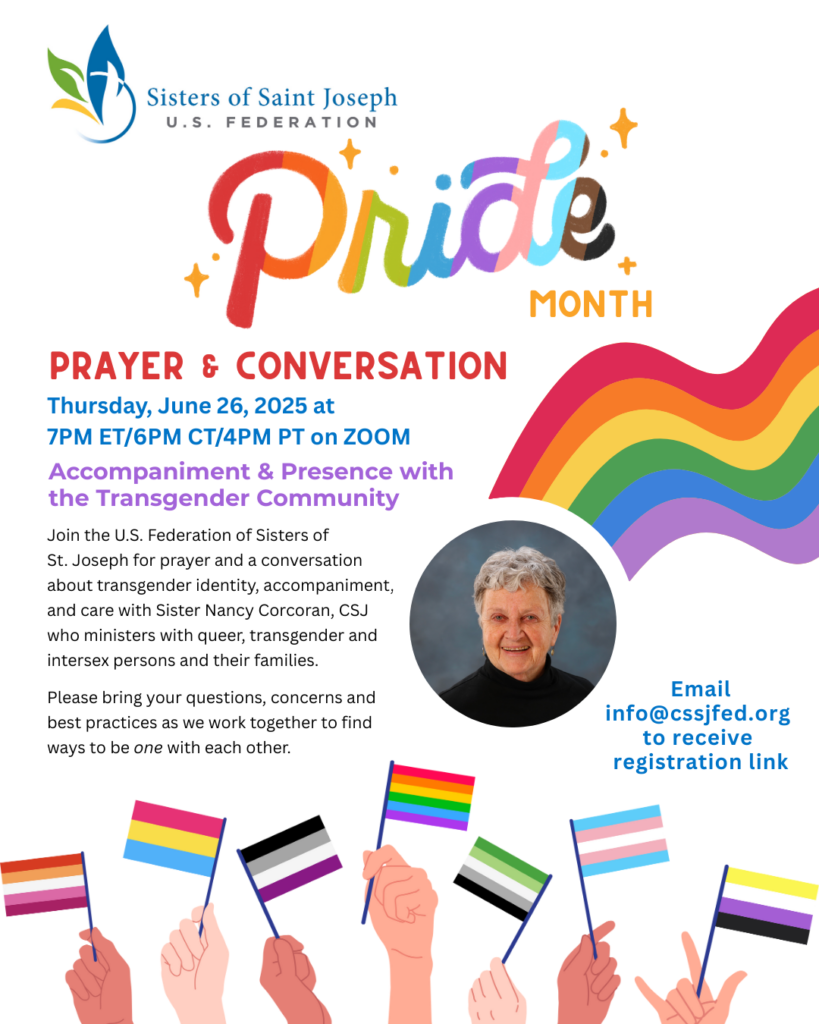By Joan Pouch, Mercy associate
Homosexual, heterosexual, cisgender, bisexual, intersex, transgender … there are a lot of terms to describe gender, sex, sexuality and gender identity, which can cause confusion. Pride Month is a good time to learn more.
Any conversation about these terms benefits from initially exploring the distinction between gender, gender identity and sex.
Gender is a complex social and psychological construct. It encompasses roles, behaviors, expression and identities that society deems appropriate for individuals based on their perceived sex. Gender is significantly shaped by social and cultural factors, which influence individuals from an early age across innumerable aspects of their life including behavior, dress, interactions, career and family roles. However, these societal norms have changed significantly, which goes to show gender is not fixed, but rather dynamic and evolving.
Gender identity refers to a person’s internal and very personal sense of their own gender. For most individuals, their gender identity aligns with the sex assigned at birth, but that is not true for everyone.
Sex refers to the biological and physiological attributes that define human beings as male, female or intersex, including chromosomes, hormones, reproductive organs and secondary sexual characteristics.
While some people cling to the concept that there are only two rigidly defined sexes, scientific identification of individuals as intersex at birth challenges the concept that biological sex is binary. An intersex person is born with sex characteristics that don’t coincide with traditional definitions of male or female, so their genitalia, reproductive organs, chromosomes or hormonal levels may not align with this binary definition. Intersex is about biology, not gender. It is not a choice.
Being intersex is a naturally occurring biological variation in humans. It is more common than people realize; there are about as many intersex people as there are red heads in the population — approximately 2%.
Journalist Rita Giordano offered insight into the intersex community in her article in The Philadelphia Inquirer* on May 12, 2025, describing the difficulties they have faced including due to invasive surgeries or medical interventions as children.
“With more than 40 known intersex variations, their identities are varied. Some intersex people are transgender and identify as a sex different from one assigned to them at birth. Other intersex individuals do identify with the sex assigned at birth,” she wrote.
They face even more challenges now as the current U.S. administration has politicized the issue and promotes policies that contradict the science.
“They’re completely erasing intersex people because our existence challenges everything that they are trying to push forward around these unscientific ideas that sex is a clear-cut binary, and there’s no variation in human existence,” said Maddie Moran, spokesperson for interACT, the nation’s largest intersex advocacy organization.
Cultural and religious beliefs, prejudice, lack of education, political agendas and fear of social stigma or retribution can create roadblocks to empathy and inclusion. Understanding that gender occurs over a spectrum calls us to a more inclusive approach that respects each person’s dignity and rights.

To learn more, join the U.S. Federation of Sisters of St. Joseph for prayer and conversation about transgender identity, accompaniment and care with Sister Nancy Corcoran, CSJ who ministers with queer, transgender and intersex persons and their families. Please bring your questions, concerns and best practices as we work together to find ways to be one with each other. All registrants will receive a recommended reading list after the conversation to further learn and understanding. Register here for Pride Month: Accompaniment & Presence with the Transgender Community, June 26, 2025, at 7 p.m. Eastern time. (English only.)
*Click here to read Rita Giordano’s article about intersex (English only, may require subscription).